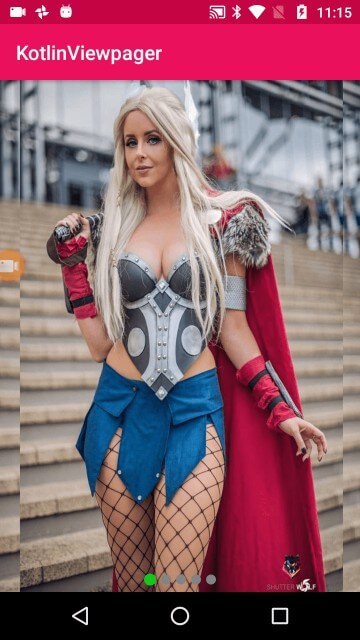Kotlin Create Slider With Page Indicator Using ViewPager Example
Last updated Jan 22, 2020 Kotlin Create Slider With Page Indicator Using ViewPager Example
Viewpager we can do a lot of things, from the simplest navigation, to the page menu and so on. Then how to use it, similar to ListView, we also need an adapter, which is PagerAdapter
In this post we are going to see page indicator on slider that are created using viewpager

Kotlin Create Slider With Page Indicator Using ViewPager Example
Step 1:Creat application in Android Stuido
Step 2: Create a model class which contains Slider item
|
import java.io.Serializable
class ViewItem : Serializable {
var imageId: Int
internal set
var imageDrawable: Int
internal set
constructor(id: Int, drawable: Int) {
this.imageId = id
this.imageDrawable = drawable
}
}
|
Step 3: Create Pager Adapter
|
class ViewPagerAdapter(internal var context: Context, internal var itemList: List<ViewItem>) : PagerAdapter() {
internal var mLayoutInflater: LayoutInflater
private var pos = 0
init {
mLayoutInflater = this.context.getSystemService(Context.LAYOUT_INFLATER_SERVICE) as LayoutInflater
}
override fun getCount(): Int {
return Integer.MAX_VALUE
}
override fun instantiateItem(container: ViewGroup, position: Int): Any {
val holder = ViewHolder()
val itemView = mLayoutInflater.inflate(R.layout.layout_item_view_pager, container, false)
holder.itemImage = itemView.findViewById(R.id.img_slider) as ImageView
if (pos > this.itemList.size - 1)
pos = 0
holder.sliderItem = this.itemList[pos]
holder.itemImage.setImageDrawable(context.getDrawable(holder.sliderItem.imageDrawable))
(container as ViewPager).addView(itemView)
holder.itemImage.scaleType = ImageView.ScaleType.FIT_XY
pos++
return itemView
}
internal class ViewHolder {
lateinit var sliderItem: ViewItem
lateinit var itemImage: ImageView
}
override fun destroyItem(container: ViewGroup, position: Int, `object`: Any) {
container.removeView(`object` as RelativeLayout)
}
override fun isViewFromObject(arg0: View, arg1: Any): Boolean {
return arg0 === arg1 as View
}
override fun destroyItem(arg0: View, arg1: Int, arg2: Any) {
(arg0 as ViewPager).removeView(arg2 as View)
}
}
|
ViewPager adapter is PagerAdapter, which is the base class that provides the adapter to fill the page ViewPager's internals. You may want to use a more specific implementation, such as FragmentPagerAdapter or FragmentStatePagerAdapter. It needs to be explained here, in fact, ViewPager should be used with Fragment, at least Google officially thinks so, but under 3.0, we do not need to do so. Note that when you implement a PagerAdapter, you must at least override the following methods:
- instantiateItem(ViewGroup, int)
- destroyItem(ViewGroup, int, Object)
- getCount()
- isViewFromObject(View, Object)
Step 4:
Add Adapter view item layout_item_view_pager.xml
|
<?xml version="1.0" encoding="utf-8"?>
<LinearLayout xmlns:android="https://schemas.android.com/apk/res/android"
android:layout_width="match_parent"
android:layout_height="wrap_content">
<ImageView
android:id="@+id/img_slider"
android:layout_width="match_parent"
android:layout_height="match_parent"
android:scaleType="fitXY" />
</LinearLayout>
|
Step 5:
Update activity_main.xml with Viewpager and page indicator layout
|
<?xml version="1.0" encoding="utf-8"?>
<androidx.constraintlayout.widget.ConstraintLayout xmlns:android="https://schemas.android.com/apk/res/android"
xmlns:tools="https://schemas.android.com/tools"
android:layout_width="match_parent"
android:layout_height="match_parent"
tools:context=".MainActivity">
<RelativeLayout
android:layout_width="match_parent"
android:layout_height="match_parent">
<androidx.viewpager.widget.ViewPager
android:id="@+id/view_pager"
android:layout_width="match_parent"
android:layout_height="wrap_content"
android:focusable="true"
android:focusableInTouchMode="true" />
<LinearLayout
android:id="@+id/lyt_page_indicator"
android:layout_width="match_parent"
android:layout_height="25dp"
android:layout_alignParentBottom="true"
android:gravity="center"
android:orientation="horizontal"></LinearLayout>
</RelativeLayout>
</androidx.constraintlayout.widget.ConstraintLayout>
|
Step 6:
Addrequired Resourses to the application
Step 7:
Add Adapter to Viewpager
|
fun initUI()
{
listViews=ArrayList<ViewItem>()
listViews.add(ViewItem(1,R.drawable.t1))
listViews.add(ViewItem(2,R.drawable.t2))
listViews.add(ViewItem(3,R.drawable.t3))
listViews.add(ViewItem(4,R.drawable.t4))
listViews.add(ViewItem(5,R.drawable.t5))
adapter= ViewPagerAdapter(applicationContext,listViews)
view_pager.adapter=adapter
}
|
Step 8: Add PageIndicators to page
|
fun addPageIndicators()
{
lyt_page_indicator.removeAllViews()
for (i in listViews.indices) {
val view = ImageView(applicationContext)
view.setImageResource(R.drawable.inactive)
lyt_page_indicator.addView(view)
}
updatePageIndicator(currentIndex)
}
|
Step 9:
Update PageIndicator on Page Selection
|
fun updatePageIndicator(position: Int) {
var imageView: ImageView
val lp =
LinearLayout.LayoutParams(LinearLayout.LayoutParams.WRAP_CONTENT, LinearLayout.LayoutParams.WRAP_CONTENT)
lp.setMargins(5, 0, 5, 0)
for (i in 0 until lyt_page_indicator.getChildCount()) {
imageView = lyt_page_indicator.getChildAt(i) as ImageView
imageView.setLayoutParams(lp)
if (position == i) {
imageView.setImageResource(R.drawable.active)
} else {
imageView.setImageResource(R.drawable.inactive)
}
}
}
|
Complete MainActivity code
|
package com.rrtutors.kotlinviewpager
import androidx.appcompat.app.AppCompatActivity
import android.os.Bundle
import kotlinx.android.synthetic.main.activity_main.*
import android.widget.LinearLayout
import android.widget.ImageView
import androidx.viewpager.widget.ViewPager
class MainActivity : AppCompatActivity() {
lateinit var listViews:ArrayList<ViewItem>
lateinit var adapter:ViewPagerAdapter
var currentIndex:Int=0;
override fun onCreate(savedInstanceState: Bundle?) {
super.onCreate(savedInstanceState)
setContentView(R.layout.activity_main)
initUI()
}
fun initUI()
{
listViews=ArrayList<ViewItem>()
listViews.add(ViewItem(1,R.drawable.t1))
listViews.add(ViewItem(2,R.drawable.t2))
listViews.add(ViewItem(3,R.drawable.t3))
listViews.add(ViewItem(4,R.drawable.t4))
listViews.add(ViewItem(5,R.drawable.t5))
adapter= ViewPagerAdapter(applicationContext,listViews)
view_pager.adapter=adapter
addPageIndicators()
view_pager.addOnPageChangeListener(object : ViewPager.OnPageChangeListener{
override fun onPageScrollStateChanged(state: Int) {
}
override fun onPageScrolled(position: Int, positionOffset: Float, positionOffsetPixels: Int) {
}
override fun onPageSelected(position: Int) {
updatePageIndicator(position)
}
})
}
fun addPageIndicators()
{
lyt_page_indicator.removeAllViews()
for (i in listViews.indices) {
val view = ImageView(applicationContext)
view.setImageResource(R.drawable.inactive)
lyt_page_indicator.addView(view)
}
updatePageIndicator(currentIndex)
}
fun updatePageIndicator(position: Int) {
var imageView: ImageView
val lp =
LinearLayout.LayoutParams(LinearLayout.LayoutParams.WRAP_CONTENT, LinearLayout.LayoutParams.WRAP_CONTENT)
lp.setMargins(5, 0, 5, 0)
for (i in 0 until lyt_page_indicator.getChildCount()) {
imageView = lyt_page_indicator.getChildAt(i) as ImageView
imageView.setLayoutParams(lp)
if (position == i) {
imageView.setImageResource(R.drawable.active)
} else {
imageView.setImageResource(R.drawable.inactive)
}
}
}
}
|

